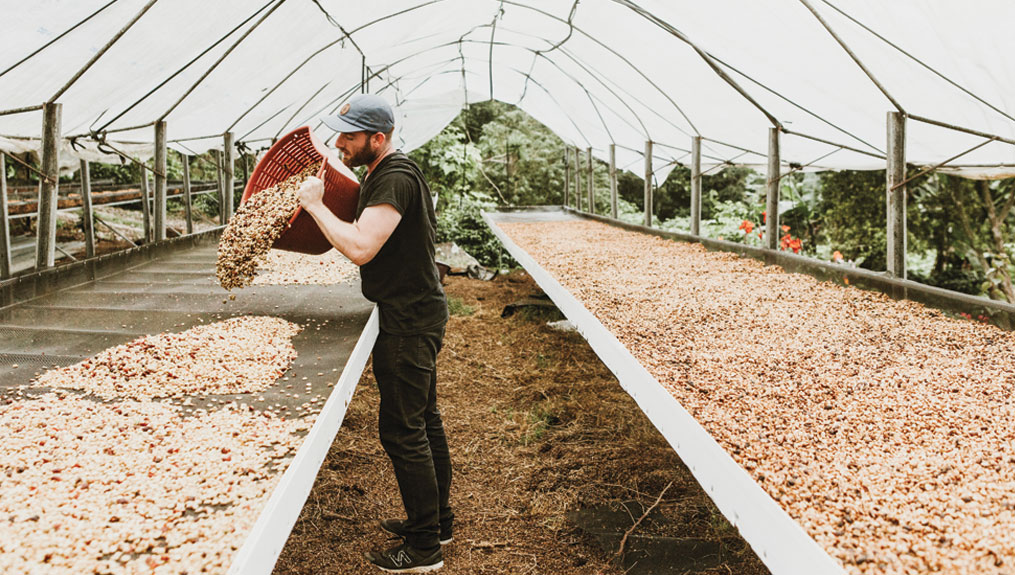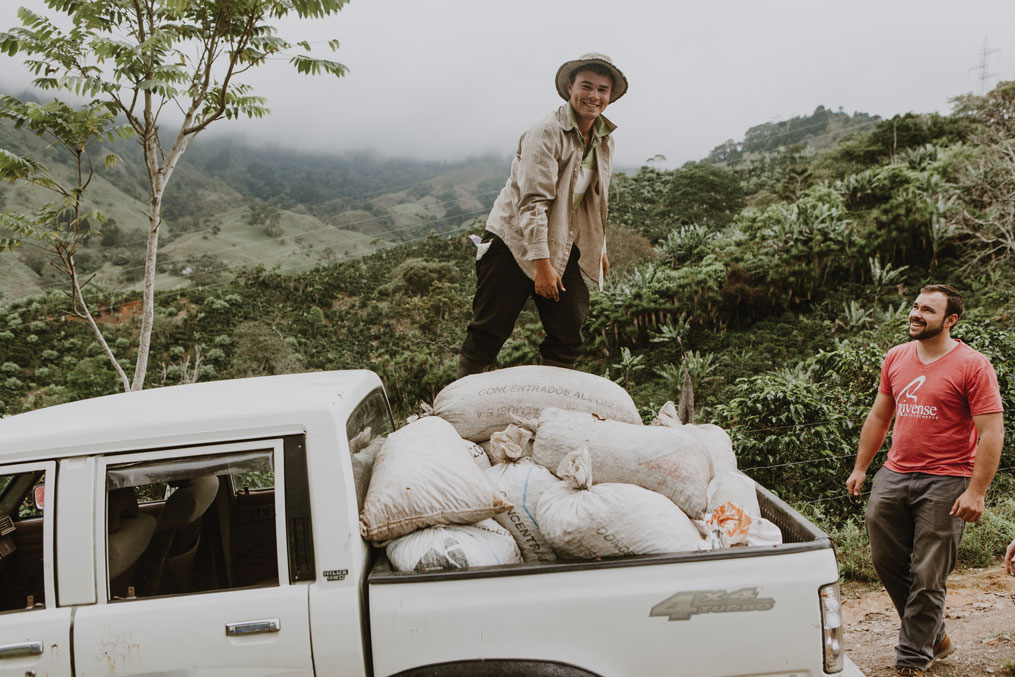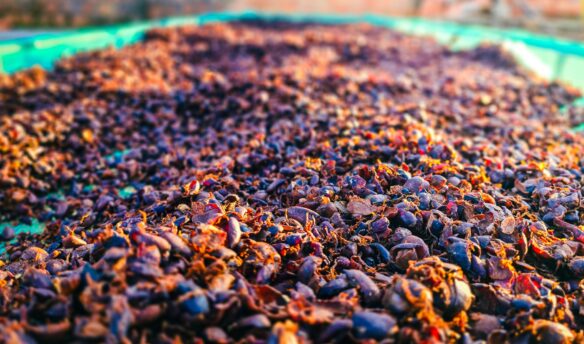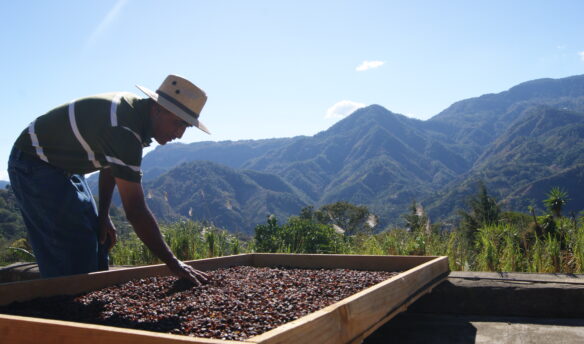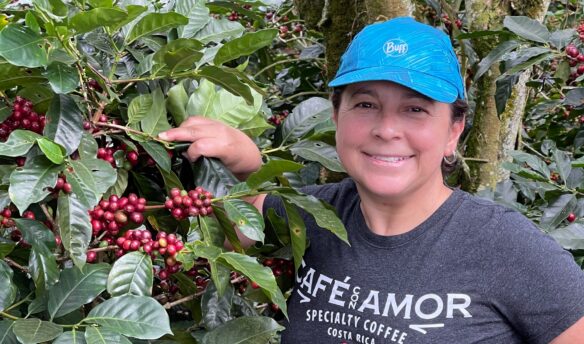Perry Czopp in Costa Rica. Photos by Cheyanne Paredes
[S]omething that makes Costa Rica coffee production and consumption so special is its yearning to explore further. Many producers in this country seek to improve and educate themselves about coffee even beyond the fact that their livelihoods may depend on it, whether it be through learning different fertilizer options, pruning techniques, varieties, and/or processing methods. At the same time, the rise of the specialty coffee movement around the globe has also affected the producing world. Farmers have started to evolve their practices in order to cater to the new and enticing demands.
Production Meets Demand
Another of the many pivotal impacts on the evolution of Costa Rican coffee was the idea of changing what was the norm of a business model for production. Typically, farmers have fields of coffee trees—tend to those fields, and when harvest comes they pick the cherries and sell them to large cooperatives/mills that most frequently apply a fully washed process to them. It was not until fairly recently that these individual farmers decided to process and sell their own coffee. The co-ops, having to keep up with the evolving market, began to experiment with different processing methods and lot separation.
Local Demand Change
Meanwhile, the culture of drinking coffee within the country began to see a shift via a handful of dedicated coffee entrepreneurs. An overwhelming majority of Costa Ricans still drink commodity coffee, like any other country, but more and more people are choosing to patronize the businesses that these visionary coffee professionals are creating. Along with inviting retail stores and online information, consumers in Costa Rica have a plethora of esteemed coffee courses to pick from. Noted schools like Asociación de Cafés Finos de Costa Rica, Academia Costarricense del Café, and Musa Lab have paved the way with their multiple and unique offerings. Courses ranging from brewing at home, roasting, and Q Grade training are made readily available to most of Costa Rica. These courses inspired a group of new baristas to make their mark on the Costa Rica coffee scene.
Jen Kalman of Franco Restaurant, an expat barista of four years in Costa Rica, comments, “All these coffee proprietors are somehow connected to coffee production. You know how integral coffee production has been to the development of the country… Everyone here has picked coffee to help out, lived next to a farm, has a family member who produces, or has studied how coffee shaped their country. So you can see why they would have the utmost respect for farmers and the product itself.”
Collaborating to Make It
The investments are of a similar magnitude. The new wet mill as the producer and the retail coffee establishment as the barista. Immense risk that is mitigated only by the drive to earn for one’s self and a passion to be considered among the best. For the farmer, having a consistent demand for coffee year after year in a direct and more lucrative fashion is highly sought out by various micro mills. Unique coffees that lend a new experience to their guests is what the baristas are after. The blending of the two necessities ends up in a symbiotic relationship that elevates the industry as a whole.
Marianela Montero of Don Eli Micro Mill, who comes from a family of coffee producers and has been exporting coffee under Nordic Approach/Tropiq for four years, states, “Unfortunately, the reality is that the best coffees do get sent to other countries. However, the producers still have seconds (the second-grade coffee that falls through larger screen sizes and higher density sorting machines) that are cupping really well and need to be sold in order to make the most of the production.”
In short, these two links in the chain work together in order to help each other succeed in a volatile market. The only thing separating the local barista from the farmer is the roasting step of the process. In most cases, this has a very low impact. A few farmers with a larger presence in the local specialty market own roasting machines and roast their own coffee. They then sell it to their wholesale partners already packed and roasted, which returns the most on their investments.
Oftentimes baristas purchase the coffee green and either rent time on a roaster or get it toll roasted by another service provider. More and more, producers are even deciding to dive in and open their own retail shops. Overall, these practices lend to more control over the roasting process and lowers the cost of coffee for the retailer while raising the price normally received by the supplier.
Improving Together
Although Costa Rica is considered to have coined the honey process, what it should be called is the “processing innovation capital.” Honey process (when cherries are pulped and their seed dried in the remaining mucilage) is essentially a creation out of a desire to use less water, while adding a unique quality to the coffee. The action of posing a question about this critical part of the coffee process, and the willingness to solve the problem, is what led to this discovery as well as the new trend of anaerobic processed coffees. The fairly recent anaerobic process occurs when cherries, or pulped seeds, are closed into a tank and deprived of oxygen for anywhere between 16-72 hours causing a controlled fermentation to occur. Some methods even use the mucilage of other coffees or the juice of other fruits in the controlled fermentation.
The results of these new and innovative processes along with the established washed and natural processes allow Costa Rica to separate itself from other producing countries when it comes to the various different products that it can provide. A catalyst of this system of improvement is the influence that the local coffee buyers have on their producers. Those retailing coffee mostly in the capital city of San José are consuming information at a speed faster than ever with ubiquitous access to the internet and other coffee professionals around the world. Often, when working closely with a producer over the years, a buyer can influence and make suggestions to producers about how to tweak their production recipes.
Together, both buyer and supplier can work together around supply and demand to not only move the industry forward, but also thrive in a difficult industry.



